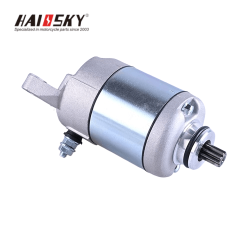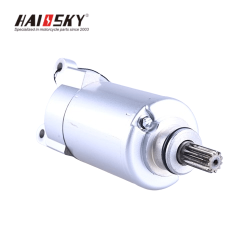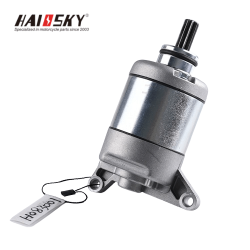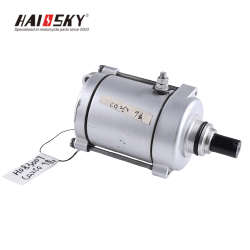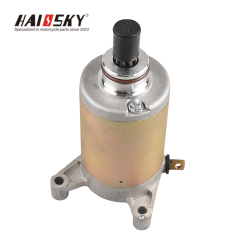OEM Motorcycle Parts
Category: Motorcycle Starter Motors - High-Torque OEM Replacements
The Ultimate Guide to Motorcycle Starter Motors: Everything You Need to Know
When it comes to starting your motorcycle, the starter motor is the unsung hero of the ignition system. This small but powerful component is responsible for cranking the engine and getting your bike up and running. For B2B wholesalers and motorcycle enthusiasts alike, understanding the ins and outs of motorcycle starter motors is essential. In this guide, we’ll dive deep into their purpose, types, maintenance, and more, while optimizing for the keyword “motorcycle starter motor” to help you make informed decisions for your business or customers.
What is a Starter Motor in a Motorcycle?
The motorcycle starter motor, also known as the cranking motor, is a critical component of the starting system. Its primary function is to convert electrical energy from the battery into mechanical energy, which is used to crank the engine and start the motorcycle. Without a functioning starter motor, the only way to start the bike would be to push-start it—a method that’s neither practical nor reliable.
Starter motors are designed to handle high torque demands, ensuring the engine turns over smoothly even in challenging conditions. They are typically powered by the motorcycle’s battery and are activated when you press the ignition button or kick-start the bike.
Types of Motorcycle Starter Motors
Starter motors come in various types, each suited to different motorcycle models and performance needs. Here’s a breakdown of the most common types:
1. Brushed DC Motors
Brushed DC motors are the most traditional type of starter motor. They use brushes to conduct electricity and create a magnetic field that turns the rotor. These motors are known for their reliability and high starting torque, making them a popular choice for many motorcycles. However, they require regular maintenance, such as brush replacement, to ensure longevity.
2. Brushless DC Motors (BLDC)
Brushless motors, as the name suggests, do not use brushes. Instead, they rely on a rotating magnetic field to turn the rotor. This design makes them more efficient, especially at high speeds, and reduces the need for maintenance. BLDC motors are also lighter, which can help improve the overall performance of the motorcycle.
3. Permanent Magnet AC Motors
These starter motors use permanent magnets to create a magnetic field, eliminating the need for an external power source. They are highly efficient and are often used in smaller or lighter motorcycles where weight and performance are critical factors.
4. Induction Motors
Induction motors are the most common type of electric motor. They work by using electrical induction to create a magnetic field that turns the rotor. These motors are durable and cost-effective, making them a reliable choice for many motorcycles. However, they are less efficient at high speeds compared to brushless or permanent magnet motors.
How to Tell if a Starter Motor is Bad on a Motorcycle
A faulty starter motor can leave you stranded, so it’s important to recognize the signs of failure. Here are some common symptoms of a bad starter motor:
The Motorcycle Won’t Start: If you press the ignition button and nothing happens, the starter motor could be the culprit.
Grinding Noise: A grinding or clicking sound when trying to start the bike often indicates a worn-out starter motor or damaged gears.
Intermittent Starting Issues: If the motorcycle starts sometimes but not others, the starter motor may be failing.
Electrical Warning Lights: Some motorcycles have a dashboard warning light that indicates an issue with the starting system.
If you notice any of these signs, it’s time to inspect or replace the starter motor.
How Do You Start a Motorcycle with a Dead Starter?
If your starter motor fails, you can still start your motorcycle using the push-start method. Here’s how:
Turn on the Ignition: Ensure the ignition switch is in the “on” position.
Shift to Second Gear: Push the motorcycle until it gains some momentum.
Release the Clutch: Once you’re moving, quickly release the clutch to engage the engine.
Give it Throttle: As the engine turns over, give it some throttle to keep it running.
While this method can save you in a pinch, it’s not a long-term solution. Replacing the faulty starter motor is the best course of action.
How Much Should a Starter Motor Cost?
The cost of a motorcycle starter motor varies depending on the type, brand, and compatibility. On average, you can expect to pay:
Budget Options:
50
t
o
50to100
Mid-Range Options:
100
t
o
100to200
High-End Options:
200
t
o
200to400
For B2B wholesalers, purchasing in bulk can significantly reduce costs. At Haissky.com, we offer competitive pricing on high-quality starter motors to meet your business needs.
Can You Push-Start a Motorcycle with a Bad Starter?
Yes, you can push-start a motorcycle with a bad starter motor, as long as the battery has enough charge to power the ignition system. However, this is only a temporary solution. A faulty starter motor should be replaced as soon as possible to avoid further issues.
What Can Be Mistaken for a Bad Starter?
Sometimes, other issues can mimic the symptoms of a bad starter motor. Here are a few common culprits:
Dead Battery: A weak or dead battery can prevent the starter motor from functioning.
Faulty Ignition Switch: If the ignition switch is damaged, it may not send power to the starter motor.
Loose or Corroded Connections: Poor electrical connections can disrupt the flow of power to the starter motor.
Bad Starter Relay: The starter relay acts as a switch between the battery and the starter motor. If it fails, the starter motor won’t receive power.
Before replacing the starter motor, it’s important to rule out these other potential issues.
Maintenance Tips for Motorcycle Starter Motors
To ensure your starter motor lasts as long as possible, follow these maintenance tips:
Regular Inspection: Check the starter motor for signs of wear, corrosion, or damage.
Clean Electrical Connections: Keep the battery terminals and starter motor connections clean and free of corrosion.
Battery Care: A healthy battery is essential for starter motor performance. Ensure the battery is fully charged and in good condition.
Avoid Over-Cranking: Cranking the engine for too long can overheat the starter motor. If the bike doesn’t start within a few seconds, stop and troubleshoot the issue.
How to Choose the Right Motorcycle Starter Motor
When selecting starter motors for your inventory or customers, consider the following factors:
Compatibility: Ensure the starter motor matches the motorcycle’s make, model, and year.
Material: Look for durable materials like steel or aluminum for long-lasting performance.
Brand Reputation: Choose trusted brands known for quality and reliability.
Voltage and Current Ratings: Verify that the starter motor’s specifications align with the motorcycle’s electrical system.
FAQs About Motorcycle Starter Motors
Q: How long do motorcycle starter motors last?
A: The lifespan of a starter motor depends on factors like usage, maintenance, and riding conditions. On average, they can last anywhere from 50,000 to 100,000 miles.
Q: Can a damaged starter motor be repaired?
A: In some cases, minor issues like worn brushes or loose connections can be repaired. However, extensive damage usually requires a replacement.
Q: What’s the difference between a starter motor and a starter relay?
A: The starter motor cranks the engine, while the starter relay acts as a switch that sends power from the battery to the starter motor.
Final Thoughts
The motorcycle starter motor is a vital component that ensures your bike starts reliably every time. By understanding its purpose, types, and maintenance requirements, you can keep your customers’ motorcycles running smoothly. At Haissky.com, we offer a wide range of high-quality starter motors to meet the needs of B2B wholesalers and riders alike. Explore our catalog today and keep the engines roaring!


